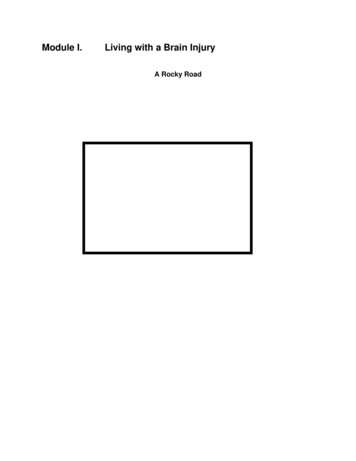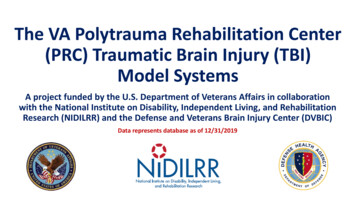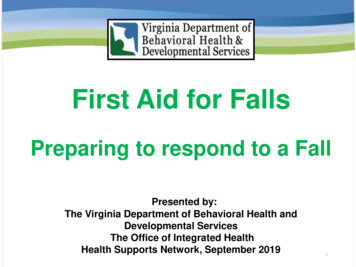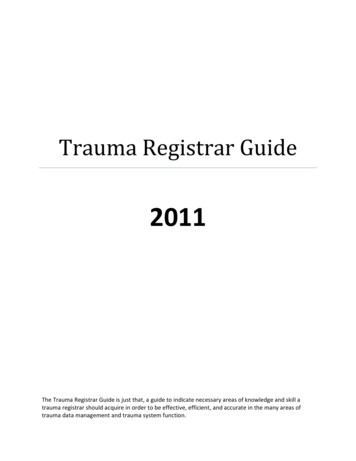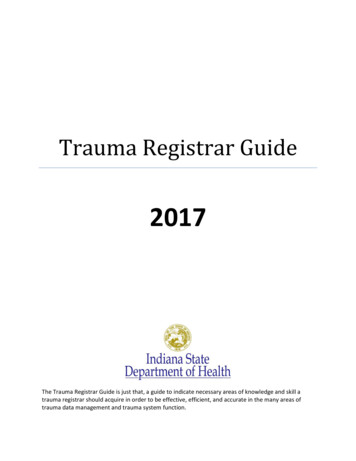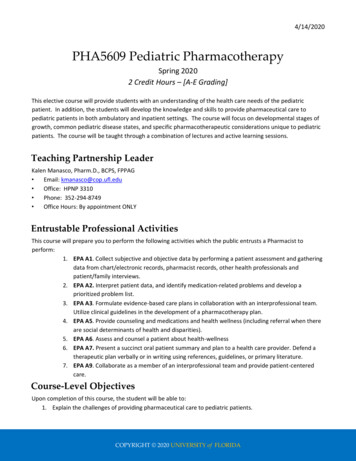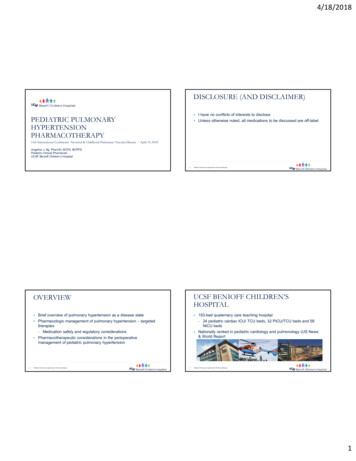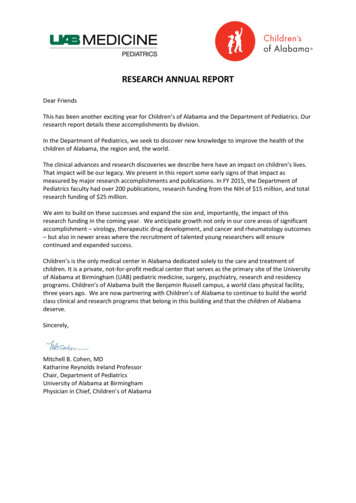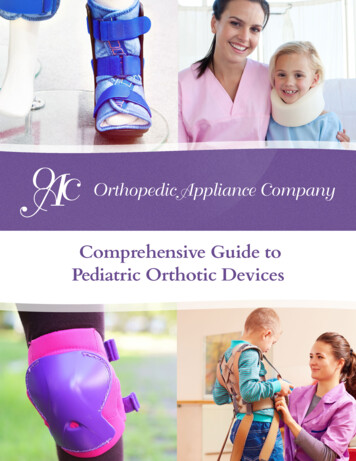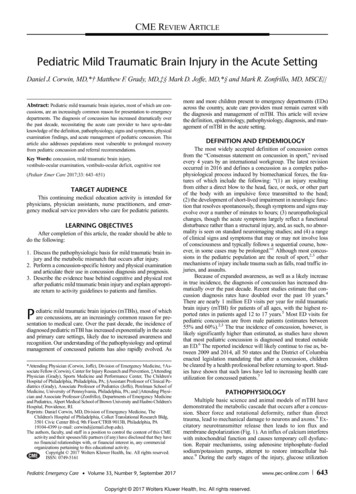
Transcription
CME REVIEW ARTICLEPediatric Mild Traumatic Brain Injury in the Acute SettingDaniel J. Corwin, MD,*† Matthew F. Grady, MD,‡§ Mark D. Joffe, MD,*§ and Mark R. Zonfrillo, MD, MSCE Abstract: Pediatric mild traumatic brain injuries, most of which are concussions, are an increasingly common reason for presentation to emergencydepartments. The diagnosis of concussion has increased dramatically overthe past decade, necessitating the acute care provider to have up-to-dateknowledge of the definition, pathophysiology, signs and symptoms, physicalexamination findings, and acute management of pediatric concussion. Thisarticle also addresses populations most vulnerable to prolonged recoveryfrom pediatric concussion and referral recommendations.Key Words: concussion, mild traumatic brain injury,vestibulo-ocular examination, vestibulo-ocular deficit, cognitive rest(Pediatr Emer Care 2017;33: 643–651)TARGET AUDIENCEThis continuing medical education activity is intended forphysicians, physician assistants, nurse practitioners, and emergency medical service providers who care for pediatric patients.LEARNING OBJECTIVESAfter completion of this article, the reader should be able todo the following:1. Discuss the pathophysiologic basis for mild traumatic brain injury and the metabolic mismatch that occurs after injury.2. Perform a concussion-specific history and physical examinationand articulate their use in concussion diagnosis and prognosis.3. Describe the evidence base behind cognitive and physical restafter pediatric mild traumatic brain injury and explain appropriate return to activity guidelines to patients and families.Pediatric mild traumatic brain injuries (mTBIs), most of whichare concussions, are an increasingly common reason for presentation to medical care. Over the past decade, the incidence ofdiagnosed pediatric mTBI has increased exponentially in the acuteand primary care settings, likely due to increased awareness andrecognition. Our understanding of the pathophysiology and optimalmanagement of concussed patients has also rapidly evolved. As*Attending Physician (Corwin, Joffe), Division of Emergency Medicine, †Associate Fellow (Corwin), Center for Injury Research and Prevention, ‡AttendingPhysician (Grady), Sports Medicine and Performance Center, The Children'sHospital of Philadelphia, Philadelphia, PA; §Assistant Professor of Clinical Pediatrics (Grady), Associate Professor of Pediatrics (Joffe), Perelman School ofMedicine, University of Pennsylvania, Philadelphia, PA; and Attending Physician and Associate Professor (Zonfrillo), Departments of Emergency Medicineand Pediatrics, Alpert Medical School of Brown University and Hasbro Children'sHospital, Providence, RI.Reprints: Daniel Corwin, MD, Division of Emergency Medicine, TheChildren's Hospital of Philadelphia, Colket Translational Research Bldg,3501 Civic Center Blvd, 9th Floor/CTRB 9013B, Philadelphia, PA19104-4399 (e‐mail: corwind@email.chop.edu).The authors, faculty, and staff in a position to control the content of this CMEactivity and their spouses/life partners (if any) have disclosed that they haveno financial relationships with, or financial interest in, any commercialorganizations pertaining to this educational activity.Copyright 2017 Wolters Kluwer Health, Inc. All rights reserved.ISSN: 0749-5161more and more children present to emergency departments (EDs)across the country, acute care providers must remain current withthe diagnosis and management of mTBI. This article will reviewthe definition, epidemiology, pathophysiology, diagnosis, and management of mTBI in the acute setting.DEFINITION AND EPIDEMIOLOGYThe most widely accepted definition of concussion comesfrom the “Consensus statement on concussion in sport,” revisedevery 4 years by an international workgroup. The latest revisionoccurred in 2016 and defines a concussion as a complex pathophysiological process induced by biomechanical forces, the features of which include the following: “(1) an injury resultingfrom either a direct blow to the head, face, or neck, or other partof the body with an impulsive force transmitted to the head;(2) the development of short-lived impairment in neurologic function that resolves spontaneously, though symptoms and signs mayevolve over a number of minutes to hours; (3) neuropathologicalchanges, though the acute symptoms largely reflect a functionaldisturbance rather than a structural injury, and, as such, no abnormality is seen on standard neuroimaging studies; and (4) a rangeof clinical signs and symptoms that may or may not involve lossof consciousness and typically follows a sequential course, however, in some cases may be prolonged.”1 Although most concussions in the pediatric population are the result of sport,2,3 othermechanisms of injury include trauma such as falls, road traffic injuries, and assaults.Because of expanded awareness, as well as a likely increasein true incidence, the diagnosis of concussion has increased dramatically over the past decade. Recent studies estimate that concussion diagnosis rates have doubled over the past 10 years.4There are nearly 1 million ED visits per year for mild traumaticbrain injury (mTBI) for patients of all ages, with the highest reported rates in patients aged 12 to 17 years.5 Most ED visits forpediatric concussion are from male patients (estimates between55% and 60%).2,3 The true incidence of concussion, however, islikely significantly higher than estimated, as studies have shownthat most pediatric concussion is diagnosed and treated outsidean ED.6 The reported incidence will likely continue to rise as, between 2009 and 2014, all 50 states and the District of Columbiaenacted legislation mandating that after a concussion, childrenbe cleared by a health professional before returning to sport. Studies have shown that such laws have led to increasing health careutilization for concussed patients.7PATHOPHYSIOLOGYMultiple basic science and animal models of mTBI havedemonstrated the metabolic cascade that occurs after a concussion. Sheer force and rotational deformity, rather than directtrauma, lead to mechanical damage to neurons and axons.8 Excitatory neurotransmitter release then leads to ion flux andmembrane depolarization (Fig. 1). An influx of calcium interfereswith mitochondrial function and causes temporary cell dysfunction. Repair mechanisms, using adenosine triphosphate–fueledsodium/potassium pumps, attempt to restore intracellular balance.9 During the early stages of the injury, glucose utilizationPediatric Emergency Care Volume 33, Number 9, September 2017Copyright 2017 Wolters Kluwer Health, Inc. All rights reserved.www.pec-online.com643
Pediatric Emergency Care Volume 33, Number 9, September 2017Corwin et alFIGURE 1. Biochemical cascade after concussion. Adapted with permission from McGinley AD, Master CL, Zonfrillo MR. Sports-related headinjuries in adolescents: a comprehensive update. Adolesc Med. 2015; 26: 491–506.to generate adenosine triphosphate is very high,10 ultimately increasing neuronal energy demand.9 Simultaneously, both pediatric and adult studies have shown that cerebral blood flow, whichdelivers glucose, decreases in response to injury, leading to an imbalance in energy supply and demand.11,12 This creates a metabolic mismatch almost immediately after injury and forms thebasis for cognitive and physical rest recommendations very earlyin the injury process. Finally, axons themselves have been shownto undergo structural damage, because disturbances in membranehomeostasis cause cytoskeletal injury.13ACUTE HISTORY: SIGNS AND SYMPTOMSOF CONCUSSIONConcussion symptoms can be classified into 3 domains:physical, cognitive, and emotional (affective; Table 1).1 Physicalsymptoms include headache, nausea, vomiting, dizziness, balanceproblems, vision problems, photophobia, and phonophobia.Cognitive symptoms include difficulty concentrating, difficultyremembering, and feeling mentally slow and foggy. Affectivesymptoms include emotional lability, irritability, depression, andanxiety. Physical symptoms tend to present earlier than cognitiveor emotional symptoms and also tend to resolve sooner.2,14 Thereseems to be a distinct entity, posttraumatic migraine, whichencompasses prolonged headache, nausea, photophobia, andphonophobia15 and can last for several months after the injury.This can occur both in migraine-prone children and in childrenwithout a history of migraine headaches. The acute care providershould be aware of the evolution of symptoms in both history taking and anticipatory guidance.In addition, during history taking, the provider must examineelements of the patient's medical history pertinent to concussionrecovery. Several populations have been shown to be at risk forprolonged recovery, including females, teenagers, those with priorconcussion, those with underlying attention-deficit/hyperactivitydisorder (ADHD) or a learning disability, and those with an underlying mood disorder (see the Special Populations section). A social history should ascertain the patient's current status in schoolto give the provider a sense of the cognitive demand that will berequired of the patient during recovery (eg, a child in elementaryTABLE 1. Signs and Symptoms of ConcussionPhysical SymptomsHeadacheNausea/vomitingBalance problemsDizzinessVision problemsSensitivity to light/sound644www.pec-online.comCognitive SymptomsEmotional/Sleep SymptomsDifficulty concentratingDifficulty rememberingFeeling foggyFeeling slowed downIrritabilityMood changesAnxietyDepressionEmotional labilitySleep disturbance 2017 Wolters Kluwer Health, Inc. All rights reserved.Copyright 2017 Wolters Kluwer Health, Inc. All rights reserved.
Pediatric Emergency Care Volume 33, Number 9, September 2017Pediatric mTBI in the Acute SettingTABLE 2. Vestibulo-Ocular Examination for ConcussionPhysical Examination ElementDysmetriaNystagmusSmooth pursuitsFast saccadesGaze stabilityNear-point convergenceGait/balance testingHow to Perform ExaminationAbnormal FindingsFinger-nose-finger, examiner's finger movinghorizontally, 10 repetitionsExaminer's finger moving horizontally, progressivelymore rapidly, stopping centrallyExaminer's finger moving horizontally, progressivelymore rapidlyExaminer's fingers shoulder-width apart (horizontal)and forehead-chin distance (vertical), 30 repetitionsPatient fixes gaze on examiner's thumb while noddingyes and then shaking head no side to side, 30 repetitionsPatient holds pen with letters at arm's length, bringstoward nose until becomes doubleTandem heel-toe gait forward and backward with eyesopen and closedSlow reaction time, past-pointing, intention tremorschool has a very different cognitive demand compared with ateenager preparing for college entrance examinations).PHYSICAL EXAMINATIONIn addition to a standard neurologic examination, there arespecialized physical examination maneuvers to evaluate for vestibular and oculomotor dysfunction, very common postconcussiveFIGURE 2. Demonstration of saccadic and gaze stability testing inthe vestibular and oculomotor examination for concussion.A, To test horizontal saccades, the examiner's fingers are placedshoulder-width apart (horizontal) or forehead-chin distance(vertical), and the patient is asked to look between them for 30repetitions. B, To test gaze stability, the patient fixes gaze on anobject (or the examiner's thumb) while nodding yes and thenshaking head no side to side for 30 repetitions. Adapted withpermission from Plant G, Splaton D. Chapter 19:neuro-ophthalmology. In: Spalton D, Hitchings R, Hunter P, eds.Atlas of Clinical Ophthalmology, 3rd ed. Elsevier Limited.Oxford, Great Britain. 2005). 1 beat of nystagmus at center of visual fieldRed/watering eyes, symptom provocation(headache, dizziness, eye fatigue)Red/watering eyes, symptom provocation(headache, dizziness, eye fatigue, fogginess)Red/watering eyes, symptom provocation(headache, dizziness, eye fatigue, fogginess)Letters become double at 6 cm from the tip ofthe noseRaises arms for stability or widens gait, extremetruncal swayingdeficits. One version of the vestibular and oculomotor examinationfor concussion, the modified vestibular/oculomotor screeningexamination for concussion, described in Table 2 and Figure 2, includes tests for (1) nystagmus, (2) smooth visual pursuits, (3) fastsaccades in both the horizontal and vertical directions, (4) gazestability testing (the vestibulo-ocular reflex), (5) near-point convergence, (6) monocular accommodation, and (7) balance/gaitstability. This test has been standardized across providers in primary care, emergency medicine, and sports medicine at one large,tertiary care pediatric institution and takes approximately 2 to3 minutes to complete.16 It can be performed in children as youngas 6 years. A similar version of this examination, the vestibular/oculomotor screening examination, has been shown to positivelycorrelate with symptom scales, with each individual elementshowing high predictive value in identifying concussed patients.17The examination has shown excellent sensitivity for concussion,because in specialty clinics, nearly 80% of concussed patientsshow at least 1 vestibular or oculomotor abnormality.18,19 In addition to its use in concussion diagnosis, the specialized examination also shows potential for helping prognosticate for patientswith mTBI, because those with abnormalities are at risk forprolonged recovery from concussion,18,20 and vestibular deficits are more prevalent in children with prolonged symptoms.21Finally, this examination has functional implications, becauseit mimics the eye-tracking demands of children in the schoolclassroom; vestibular and oculomotor deficits can impactschool reentry and allow the provider to predict potential areasof difficulty in the school-aged population. It should be notedthat although performing a version of the examination is feasiblein the office or emergency setting, and the 2016 InternationalConsensus Statement on Concussion recommends performing aversion of vestibular and oculomotor testing in this setting,1 currently, administration of the full spectrum of testing is not widespread and is yet to become a standard of care. We do anticipatethat because of its use for diagnosis and its prognostic value, moreand more clinicians will perform vestibular and oculomotor examinations over the coming years in children with concussion.NEUROIMAGING AND LABORATORY TESTINGDiagnosis of mTBI is made by history and physical examination, and in general, it does not require neuroimaging. Consensusstatements agree that imaging via either computed tomographic(CT) scan or magnetic resonance imaging (MRI) of the head contributes little to the diagnosis of concussion.1 In the ED, CT scan 2017 Wolters Kluwer Health, Inc. All rights reserved.Copyright 2017 Wolters Kluwer Health, Inc. All rights reserved.www.pec-online.com645
Pediatric Emergency Care Volume 33, Number 9, September 2017Corwin et alshould be used when the clinician has suspicion for skull fractureor intracranial hemorrhage. Multiple studies have developed decision models to help rule out clinically significant intracranial hemorrhage, the largest and most widely used of which was publishedby Kuppermann et al22 in 2009. Of note, there is overlap betweenthe higher-risk features of traumatic brain injury in this study andsymptoms of concussion, and not all patients who fail to meet thevery low risk criteria in this study require a head CT.Like CT, MRI has little role in the immediate diagnosis ofconcussion. Most MRI findings obtained on patients with mTBIare normal.23 In patients with prolonged symptoms, MRIs are useful if the clinician is entertaining alternative diagnoses beyondpostconcussive syndrome (eg, a space-occupying lesion). Morerecently, functional MRI (f MRI) has been used in patients recovering from mTBI, to show subtle abnormalities, even inasymptomatic patients.24,25 In the future, f MRI may play a rolein helping rehabilitate patients with prolonged recovery but currently does not play a role in the acute management of concussion.Previously, there was little role for laboratory testing in thesetting of mTBI, although more recently, several serum biomarkers have been studied. Glial fibrillary acidic protein (GFAP),an intermediate filament expressed by astrocytes, has been shownto correlate with CT findings in those with more severe TBI in pediatric patients.26 Recently, a pilot study in children with mTBIdemonstrated that levels of GFAP in the serum drawn shortly afterthe injury correlate with symptom burden both initially and1 month after the injury.27 This suggests that there may be a rolein the future for GFAP, among other potential candidate markers(including S100 calcium binding protein B, myelin basic protein,and ubiquitin C-terminal hydrolase-L1), as potential indicators formore severe concussion.28NEUROCOGNITIVE TESTINGMany computerized neurocognitive testing batteries areavailable for children experiencing concussion, which can becompleted in a relatively short period. Prior studies have shownthat such testing is feasible in an ED setting,29 although one mustkeep in mind that many acutely concussed children are too symptomatic to complete neurocognitive testing, and exposing childrento these batteries in the acute setting may solely serve to exacerbate symptoms. The utility of neurocognitive testing acutelyis somewhat controversial; some studies have shown that patients with mTBI perform worse on computerized testing whencompared with healthy controls,29,30 even when asymptomatic,whereas other studies have shown that lower raw scores onneurocognitive testing in the ED do not predict prolonged recovery.31 Likely, more useful than raw data is comparison between a patient's baseline testing and his or her performanceafter an mTBI. However, even with patients who have baselinetesting available, there are limitations; for example, studies showthat patients do worse on baseline testing with less sleep,32 so asimilar score between baseline and after a potential injury wouldnot necessarily rule out concussion. The most important use ofsuch testing is likely in trending scores as a patient recovers anddetermining clearance for return to sports.33 Ultimately, neurocognitive testing, in conjunction with history and physical examination findings, may play a role in concussion diagnosis butshould serve as an adjunct and not a primary diagnostic tool.in children and youth is cognitive and physical rest. Given thepathophysiology of concussion and the metabolic mismatchthat occurs early in the course of injury, some degree of restis likely beneficial during the early recovery phase. However,the optimal dose and duration of rest remain controversial, withequivocal findings in the literature.Early studies showed improvement in symptoms amongthose who rested at least 1 week after injury, although in the largestearly study, there was no comparison group.35 More recent studieshave demonstrated that prolonged rest may actually be detrimental. Thomas et al36 randomized a group of patients aged 11 to22 years to either 5 days of strict rest or 1 to 2 days of rest followedby a stepwise return to activity, and the strict rest group had an increased number and a slower resolution of symptoms. Buckleyet al37 randomized 50 college-aged athletes either to strictly restfor 48 hours or to not receive specific postinjury instructions,and the “no-rest” group was symptom-free sooner (5.2 vs 3.9 days).The provider must consider the psychological consequences ofprescribing physical and cognitive rest; DiFazio et al38 have described an “Activity Restriction Cascade,” whereby removing achild from validating life activities, combined with physical deconditioning, contributes to the development of persistent postconcussion symptoms and lengthens recovery. In addition, incontrast to prior recommendations that suggested complete abstinence from physical exercise while symptomatic, recent studieshave also shown that early exercise may not only reduce symptomsbut also reduce abnormalities in brain activity on fMRI imaging.39At the same time, the provider must be cautious inrecommending early return to full activity, as too much activitytoo soon may prolong recovery. Brown et al40 recently showedthat those in the highest quartile of cognitive activity within thefirst 3 weeks after injury had a more prolonged recovery, andSilverberg et al41 showed that sharp increases in mental activitylead to an increased risk of symptom spikes (it should be noted,however, that symptom spikes in and of themselves were not arisk factor for a prolonged recovery). In addition, early cognitiveand physical activity should not be equated with early returnto activities that may result in another head injury. A second injury, before the full recovery of the first injury, may have severeconsequences. Both basic science and animal models haveshown a reinjury during a vulnerable window, usually within1 to 2 weeks of injury, and may result in persistent and possiblypermanent injuries,42,43 including ion channel dysfunction, structural neuronal damage, and cognitive impairments.44–46In recommending return to activity in the acute setting, theacute care provider must consider the eye-tracking demands requiredin the classroom. Reading, using a computer screen, taking notes,and viewing objects close to one's face can be difficult if the childstill has abnormalities in the vestibular and oculomotor examination (eg, horizontal saccades mimic reading a book, and verticalsaccades mimic looking up at a board or screen and taking notes).The optimal duration of rest after concussion remains unclear,but there is enough evidence to recommended period of 24 to48 hours of rest, followed by graduated return to activity in concertwith a primary care provider, a recommendation supported by theInternational Consensus Statement.1 Clinicians can expect theserecommendations to be refined in the coming years as more research on the treatment of concussions is undertaken.MANAGEMENT: COGNITIVE AND PHYSICAL RESTMANAGEMENT: MEDICATIONSOn the basis of consensus statements and expert opinion,both from the International Conference on Concussion1 andthe American Academy of Pediatrics Council on Sports Medicine and Fitness,34 the standard of care for treatment of mTBIIn the acute setting, analgesics including acetaminophen andibuprofen can provide some pain relief (especially in the setting ofa contact-related injury); however, they generally are not helpfulduring the recovery phase and should not be continued after ED646www.pec-online.com 2017 Wolters Kluwer Health, Inc. All rights reserved.Copyright 2017 Wolters Kluwer Health, Inc. All rights reserved.
Pediatric Emergency Care Volume 33, Number 9, September 2017discharge. Often, such symptoms occur as a result of excessivecognitive activity and usually only improve with rest. If, duringthe acute stages of concussion, patients are requiring pain medication to enable participation in physical and cognitive activities,they are likely overexerting themselves. Sleep disturbances, whichcan occur shortly after a concussion, can be treated with melatoninin the acute setting.47 Other medications have been trialed outsidethe acute setting for those patients with persistent postconcussivesyndrome, including gabapentin, topiramate, and amitriptyline.Although a complete discussion of their efficacy is beyond thescope of this review, amitriptyline has been shown to be most effective for postconcussive headaches.48SPECIAL POPULATIONSNumerous studies have shown that certain populations are atrisk for a prolonged recovery from concussion and therefore mayrequire closer follow-up.AgeCompared with college-aged athletes and adults, adolescentshave demonstrated prolonged recovery time.49,50 Amongschool-aged children and teenagers, there is controversial evidence regarding which patients are at the highest risk for prolonged symptoms. Some studies show that the youngest patientstake longer to recover,3 whereas others indicate that teenagersare predisposed to a longer duration of symptoms than youngerchildren.51,52 There are likely some confounding factors in the differential recovery by age, because younger children may be inclined to report symptoms less frequently than older teenagers;in addition, older teenagers experience a larger cognitive burdenupon return to school. In terms of neurocognitive testing, thereseems to be a trend of prolonged recovery time by age: adults(older than 22 years) have been found to return to baseline in 3to 5 days; college-aged young adults (age, 18–22 years) recoverin 5 to 7 days; and high school students (age, 14–17 years) recoverin 10 to 14 days.53,54 It has been hypothesized that the pediatricbrain may have increased susceptibility to neurotransmittermediated excitotoxicity as mechanism for the longer recoverytime when compared with adults.55SexMultiple studies have shown the females take longer to recovercompared with males.51,56 Although females do report more baseline symptoms compared with males, they take longer to return totheir baseline after an mTBI.57 After concussion, females have beenshown to score more poorly on neurocognitive testing.58Prior ConcussionsMany studies have shown that a history of multiple ( 2)prior concussions is an independent risk factor for a prolongedrecovery.59,60 More recent studies have suggested that any priorconcussion may predispose children to prolonged duration ofsymptoms.56 On neurocognitive testing, those with a history ofat least 1 concussion perform worse when recovering from a second injury compared with those who have never experienced aprior concussion.61Mood Disorder and Learning DisabilitiesMood disorders (both anxiety and depression) have beenshown to increase the risk of development of postconcussive syndrome, as well as the risk for prolonged duration of symptoms andrecovery.3,62 Children after concussion report significant moodrelated symptoms and can develop novel psychiatric diagnoses,63Pediatric mTBI in the Acute Settingalthough it is unclear if these come about as a result of the mTBIor represent an underlying diagnosis that is unmasked by theinjury. Those with a strong family history of mood disordersare likely at higher risk to develop depression and anxiety afteran injury. In addition, those children with ADHD have beenshown to be at risk for prolonged recovery.56 Interestingly, thosewith ADHD are actually at higher risk to sustain a concussion,in addition to their risk for prolongation of symptoms.64Prolonged Recovery or More Likely toReport Symptoms?Some researchers have proposed that several of these underlying conditions may not necessarily predispose children to a prolonged recovery but rather represent conditions whereby childrenare simply more likely to report symptoms. Iverson et al65 examined symptom reporting in nonconcussed children and found thatgirls, those with mood disorders, and those with migraine headaches were more likely to endorse symptoms resembling concussion than those without these conditions. Although a propensity tooverreport symptoms may partially explain the prolonged recovery in these specific groups, there likely is also an element of trueprolongation of symptoms. Regardless, the acute care providermust be cognizant of the risks in concussed patients with theaforementioned underlying conditions.FOLLOW-UP AND REFERRALPrior research has estimated that symptoms in most mTBIpatients (as high as 80%–90%) will resolve within 4 weeks.66Both studies and position statements have emphasized that mostconcussions can be managed by primary care providers.16 Referral to concussion specialists is indicated for patients who experience symptoms unresponsive to traditional rest after 3 weeks.These specialists can help coordinate education and neuropsychological resources, as well as facilitate referral to specialized physical therapists. Studies have proven that visual and oculomotortherapy can be successful for those with prolonged visual andvestibular complaints.67In providing referral and follow-up, the acute care providershould be aware of the specialized populations mentioned previously, as, given their risk to prolonged recovery, they likely will require closer follow-up. Tools exist to aid the clinician in helpingprognosticate for families. For example, recently, the PediatricEmergency Research Canada Concussion Team published a clinical risk score for predicting persistent postconcussive symptomsfrom the ED, which includes points for being teenage, femalesex, prior concussion history, migraine history, answering questions slowly, errors in balance testing, and reported symptoms ofheadache, sensitivity to noise, and fatigue.52CONCLUSIONSPediatric mTBI is an increasingly common reason for presentation to medical care. As the incidence of concussion diagnosis continues to rise, it is imperative for acute care providersto have an understanding of the epidemiology and pathophysiology of concussion, an awareness of specialized elements ofthe history and physical findings when evaluating the potentiallyconcussed patient, a knowledge of appropriate recommendationsfor rest and rehabilitation, and an appreciation of special, vulnerable populations at risk for a prolonged recovery.REFERENCES1. McCrory P, Meeuwisse W, Dvorak J, et al. Consensus Statement onConcussion in Sport—the 5th international conference on concussion 2017 Wolters Kluwer Health, Inc. All rights reserved.Copyright 2017 Wolters Kluwer Health, Inc. All rights reserved.www.pec-online.com647
Pediatric Emergency Care Volume 33, Number 9, September 2017Corwin et alin sport held in Berlin, October 2016. Br J Sports Med. 2017.[Epub ahead of print].2. Eisenberg MA, Meehan WP 3rd, Mannix R. Duration and course ofpost-concussive symptoms. Pediatrics. 2014;133:999–1006.3. Corwin DJ, Zonfrillo MR, Master CL, et al. Characteris
departments. The diagnosis of concussion has increased dramatically over the past decade, necessitating the acute care provider to have up-to-date ymptoms,physical examination findings, and acute

